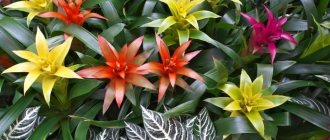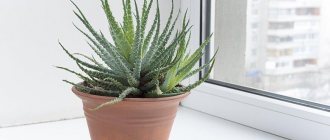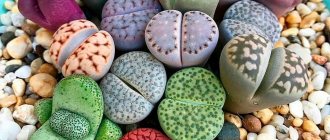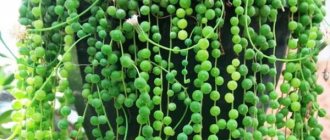The herbaceous evergreen terrestrial or epiphytic plant Guzmania, also called guzmania, is a member of the Bromeliad family. This genus includes approximately 130 species. In nature, such plants are found in Brazil, the West Indies, Venezuela, Central America and southern Florida. They prefer to grow on open mountain slopes at an altitude of approximately 2.4 thousand meters above sea level. In 1802, this genus was described for the first time, and it was named in honor of the Spanish zoologist, botanist, and pharmacist A. Guzman, who studied South America. Today, a large number of species of this plant are grown indoors. This flower has a spectacular rosette consisting of long leaf plates, as well as an unusual inflorescence, which is shaped like a cone. However, the main feature of Guzmania is its long flowering.
Brief description of cultivation
- Bloom . Each Guzmania rosette blooms only once, after which it dies.
- Illumination . The light should be bright and diffused.
- Temperature regime . The air temperature should not be higher than 27 degrees and lower than 13 degrees. This flower grows best at a temperature of 25 degrees during active growth and development, and at 20 degrees during the flowering period.
- Watering . It is carried out immediately after the top layer of soil mixture in the pot has dried a little.
- Air humidity . It should be elevated. To do this, the bush is moistened every day from a sprayer with well-settled lukewarm water.
- Fertilizer . Fertilizing is carried out from March to September once every 4 weeks; for this purpose, fertilizer for bromiliaceae is used, and the concentration of the nutrient solution should be 2 times less than what is written in the instructions.
- Transplant . This flower does not need to be replanted.
- Reproduction . In rare cases, by seeds, and most often by lateral shoots.
- Harmful insects . Scale insects, mealybugs and spider mites.
- Diseases . Root and gray rot.
Feeding the guzmania flower when caring for it
Guzmania can easily do without fertilizing. But for better formation of peduncles and long flowering, you can apply fertilizers intended for bromeliads or orchids in spring and summer. The fertilizer is diluted in water and poured into the outlet. It is enough to do this once a month.
If you want to see photos of the anthurium flower, you can find them on this page.
Detailed instructions for propagating anthurium are here:
You can read how to detect and treat anthurium diseases in time in our guide.
Features of Guzmania
Like all representatives of the Bromeliad family, guzmania has leaf plates at the base that overlap each other, forming a kind of bowl for water; it accumulates it for itself, but in nature other forest inhabitants also use it. As a rule, the leaf plates are monochromatic, but there are types with transversely or longitudinally striped foliage. The length of the leaf plates varies from 0.4 to 0.7 m; they form a rosette, which on average reaches about 50 cm in diameter, however, there are species that are both smaller and more compact. In different species, peduncles may have different lengths. Flowering begins in March or September and lasts for several months. The flowers have no decorative value. However, the bracts of Guzmania are spectacular, as if varnished; they are colored yellow, orange, red or white and have a length of 40 to 50 mm. Such bracts form an extremely unusual inflorescence. The height of an adult bush is about 0.75 m, while its width is up to 0.6 m. However, in indoor conditions, the height of such a flower rarely exceeds 0.4 m. After the bush has flowered for 6 months, it dies.
Guzmania (Guzmania, Gutzmania). How to Care for Guzmania. Beautiful Bromeliads
Caring for Guzmania at home
To grow guzmania indoors, a gardener needs to know how to properly care for it. This flower is heat-loving; it grows normally only with high air humidity and requires bright, but diffused light without direct rays of the sun.
Temperature
A plant that is preparing to flower needs warmth, and the air temperature in the room should not fall below 25 degrees. The flowering bush can be located in a cooler place (about 20 degrees). Such a plant can withstand a temperature drop of up to 13 degrees for a short time. Despite the fact that guzmania is heat-loving, it cannot be exposed to high temperatures (more than 27 degrees) for a long time, otherwise it can lead to the death of the bush.
Air humidity
In order to maintain the high air humidity in the room that this flower needs, you need to moisten it every day from a sprayer; for this you need to use filtered water, but distilled water is better suited for this purpose. During the period from October to February, the flower should be moistened only in the mornings. When spraying the bush, you must ensure that the liquid does not fall on the surface of the bracts, as this significantly reduces the duration of flowering.
Watering rules
To water and spray such a plant, you can only use distilled or filtered water, because its root system is extremely sensitive to lime and chlorine. The water must be warm (about 20 degrees). It is necessary to water the flower in such a way that the substrate is always slightly damp. Watering is carried out immediately after the surface of the soil mixture begins to dry out. Water should be poured directly into the leaf outlet. The frequency of watering is directly related to the temperature and humidity in the room. If the air temperature and illumination are less than those recommended by experts, then watering will be more rare, but even in this case, it is necessary to moisten the foliage with lukewarm water every day. In the spring-summer period, when intensive growth of the bush is observed, it especially needs moisture.
Fertilizer
To feed Guzmania, use fertilizer for bromeliads, which can be purchased at a specialty store. When preparing a nutrient solution, it should be taken into account that its concentration should be a couple of times less than that indicated in the instructions. Make sure that the fertilizer does not contain copper or boron, as the plant reacts extremely negatively to them. Feeding is carried out from March to September once every 4 weeks. The nutrient solution is poured directly into the leaf rosette or the bush is moistened with it from a sprayer.
Guzmania transplant
This plant is transplanted only once: from the container in which it grew in the store to your own. But they do this only when necessary. The root system of such a plant is small; therefore, a pot for replanting it must be chosen that is no more than 10–12 centimeters in diameter. Since the bush can turn the pot over as it grows, it needs to be weighed down with something. Also, for stability, the container can be placed in a decorative flowerpot. Don't forget to make a good drainage layer at the bottom of the pot. The soil mixture should drain water well, and its pH should be 5.5–7.0. Approximate soil mixture compositions:
- fern and crushed sphagnum roots (3:1);
- sand, leaf soil, moss and pine bark (1:2:1:2);
- humus, peat, sand and turf soil (2:4:1:2).
If you don’t want to make your own soil mixture, you can use one ready for orchids or ferns.
Place a drainage layer on the bottom of the pot and pour a small amount of soil mixture into it, then the bush is transplanted by transferring it from the old container to the new one, while being careful not to destroy its earthen lump. Then all the voids must be filled with the prepared soil mixture. Remember that the roots of the flower are very fragile, so you need to be extremely careful.
transplanting Guzmania to a bromeliad tree
After flowering
Each Guzmania bush blooms only once. Experts consider this plant to be an annual plant, but sometimes it takes more than one year to wait until it blooms. The faded bush gradually dies. If he produces children, they can be transplanted. However, the parent bush will still die.
Reproduction methods
Seating rules
Below we will talk in detail about the method of propagation of guzmania, about dividing the bush and about planting children. The fact is that all these procedures are identical. After the bush fades, it forms lateral shoots called children. The faded parent rosette dies over time, but several lateral shoots form around it, which eventually form their own root system. The babies are planted after the length of their roots is equal to one and a half centimeters. The baby is cut off from the mother bush with a very sharp, pre-sterilized instrument, and the cut points on both the shoot and the old bush are smeared with garden varnish. The formation of roots at the lateral processes occurs at different rates, and therefore it will most likely not be possible to transplant them at once. The children are planted in individual pots, which are filled with soil mixture for orchids, after which they are transferred to a warm place. At first, the planted children must be covered from above with a plastic cap, since they need constant high air humidity. Grown and strengthened bushes are planted in permanent pots, using the transshipment method, while trying not to injure the fragile roots.
How to separate Guzmania babies
Propagation of Guzmania by seeds
This crop can also be propagated by seed. To begin with, the container is filled with a substrate for bromeliads, which includes sand and crushed peat. The seeds are washed in a solution of potassium manganese, dried well, and then evenly distributed over the surface of the soil mixture. There is no need to bury them in the soil, since for germination they will need a large amount of light, and the surface of the container must be covered with film or glass. The crops are placed in a warm place (from 22 to 24 degrees), and one must not forget to systematically ventilate them and, if necessary, moisten the substrate from a spray bottle using lukewarm water. The first seedlings should appear after 15–20 days. Picking is carried out after the seedlings are 8–10 weeks old; for this, a soil mixture is used, which includes peat, leaf and turf soil (4: 2: 1). Half a month after this, the bushes are transplanted into permanent pots. Flowering bushes grown from seeds can be seen after 3–5 years.
Transfer
We have found out everything about propagation, but how can you transplant a plant? It is worth noting that guzmania grows quite slowly, the plant can live quietly in your pot for several years, and replanting will not be required. Most often, it is carried out only if the pot is damaged or you simply decide to move the flower immediately after purchasing it (transport pots, as a rule, do not have an exclusive design). Here's what you'll need to do:
• Prepare a medium-sized pot (no more than 15 cm) in advance, fill its bottom with drainage stones; • After this, prepare the necessary soil, it should consist of peat, turf soil, sphagnum and sand. If you have no desire to do this work, you can immediately purchase the ready-made mixture; • Now carefully pull out the plant itself, while keeping an eye on the roots all the time, they should not be damaged. Place the flower in a new pot and fill it with the prepared mass on top; it should be packed tightly enough; • Finally, simply water the plant with filtered water.
Popular articles Liatris - a bright accent in your flower garden
In the event that you are replanting a new plant that has formed from an old shrub, do not forget to untangle their roots when pulling them out. After this, the old plant will need to be thrown away.
Now you know what a guzmania flower is, how it is propagated and how the transplantation proceeds. If you have been dreaming of some exotic flower for a long time, but don’t know what to choose, then without hesitation, buy guzmania. Other indoor plants are unlikely to be able to boast such easy care, and in addition, guzmania has a stunning appearance that will not leave anyone indifferent.
https://youtube.com/watch?v=Vs2Rga4ZI1M
Possible problems
- Excessive watering may cause root rot .
- Guzmanias are often affected by fungal diseases due to being kept in too warm and humid rooms.
- Brown spots on the leaves indicate sunburn.
- The tips of the leaves turn brown when there is insufficient air humidity, as well as watering with hard water or the lack of the required amount of water in the outlet.
- The death of the plant after flowering is completed is a natural process.
- The appearance of yellow spots on the leaves with gradual yellowing and death of the leaf as a whole indicates a red spider mite infestation.
- The appearance of brown plaques-tubercles on the leaves - the plant is affected by bromeliad scale.
- If the leaves are covered with a white cotton wool-like fluff , it means that mealybugs have occurred.
- If the plant does not form daughter plants , it means it does not have enough nutrients.
- Drooping and soft leaves indicate a low temperature for keeping Guzmania.
Types of Guzmania with photos and names
Guzmania reedulata
In indoor conditions, guzmania reed is most often cultivated - this is a flower that can grow as an epiphyte and as an epilith (on rocky soil). The base of such a plant is a rosette, consisting of long and dense leaf plates of a wide-linear shape and green color; in the middle it has a corolla of saturated-colored bracts. Such a corolla can be confused with a flower. Real flowers are part of the spike-shaped inflorescence, but they do not have any decorative value, and the flowering does not last very long. This type has several varieties:
- Purple (var. cardinalis) . The spreading rosette consists of green leaf plates, the width of which is 30–40 mm. The inflorescence has a red, scarlet or purple color. The inflorescence is multi-flowered. Flowering is observed in March and September.
- Modest color (var. concolor) . The rosette consists of greenish leaf plates. The pale orange bracts have deeper colored tips.
- Fiery (var. flammea) . The rosette consists of green leaf plates, the length of which is from 24 to 34 centimeters, and the width is from 1 to 2 centimeters, they are directed in all directions of the upper hemisphere. The bracts directed towards the zenith are painted in a fiery red hue. Flowering is observed in July and August, and small-flowered inflorescences are formed.
- Regular (var. lingulata) . The socket consists of sheet plates 25 mm wide. The color of erect bracts is pink or red. Flowering occurs in March, August and December.
- Small (var. minor) . The rosette consists of leaf plates of green-red or green color, the width of which is about 25 mm. Bracts of red or lemon-yellow leaf blades can be spreading or erect.
Guzmania Donnell-Smith
It has a loose rosette consisting of green leaf plates with scales of a paler shade. On an erect peduncle, a short pyramidal-paniculate inflorescence is formed, which at the base is covered with imbricated bracts of a deep red color. Flowering is observed in April and May.
Guzmania blood red
The goblet-shaped rosette consists of wide-linear leaf plates. The deep red bracts are thin. The corymbose inflorescence has a leaf-shaped involucre, its peduncle is undeveloped, so it is immersed in a leaf rosette. This type has several varieties:
- Bloody (var. Sanguinea) . The bracts are rounded with a sharp tip. The flowers are white or greenish-yellow. Flowering is observed in April and August.
- Short-legged (var. Brevipedicellata) . The pointed bracts are helmet-shaped.
Guzmania musaica, or mosaic
A spreading rosette is formed from long leaf plates. On the straight peduncle there are pointed broadly elliptical stipules of a deep pink color. A simple capitate inflorescence consists of 20 yellowish-white flowers, its base hidden by stipules. This species has varieties such as:
- Musaica - greenish leaf plates striated with irregular lines, flowering is observed in June and September;
- Concolor - single-color foliage;
- Zebrina - the foliage has wide stripes.
Nicaraguan Guzmania (Guzmania Nicaraguensi)
The bush has tongue-like foliage, which tapers towards the top; along the lower part it is covered with faded dense scales, which disappear over time. Instead of scales, small longitudinal red streaks form on the foliage. The leaf rosette has a goblet shape; a spindle-shaped simple inflorescence is immersed in it, on which not many yellow flowers grow. Flowering is observed in March and May.
Guzmania monostachia
The rosette includes a large number of greenish-yellow leaf plates, while those located below are more faded than those at the top, and on their surface in some places there is a coating consisting of small dotted scales, which fly off over time. At the top of the bare peduncle grows an elongated multi-row spike consisting of white flowers. Sterile flowers have white or deep red bracts, while fruit-forming flowers have faded bracts with brown longitudinal marks. There are the following varieties:
- Monostachia - leaf blades are monochromatic, faded bracts have longitudinal chocolate-colored streaks, flowering is observed in June and July;
- Variegata - there are white streaks on the green leaf blades;
- Alba - solid green foliage, upper bracts are white, and lower ones are also green.
Types and varieties
Unfortunately, only some varieties of the Guzmania variety have been adapted to the indoor environment, but even this small amount can change the overall appearance of the mini-garden, adding grace, beauty and spring warmth.
Next, it is proposed to familiarize yourself with those varieties that have managed to take root in the home environment.
"Reed" In terms of its dimensions, the plant can be quite large, due to which it is the pride of any gardener’s collection. The maximum length of the bright green leaves is 50 cm. Their reverse side is decorated with brownish stripes. Despite the slight spreading of the leaves of the flower structure, their dense structure forms a strong rosette at the base of the plant, designed to collect and store liquid. The peduncle is small in size. Its leaves can be red or orange. The flowers in the central part of the peduncle are dwarf in size and yellow-white in color. The flowering period lasts for three weeks. At this time, the flower takes on a majestic appearance. After the time allotted by nature, the central part of the flower becomes faded and fades, but despite this, guzmania continues to live, releasing daughter rosettes.
"Tempo." In terms of its characteristics, the plant is very similar to the “Minor” variety, the only difference is its size. The spreading bright green leaves create a strong rosette due to the dense structure at the base. The bright peduncle, often red, is complemented by white splashes on the leaves.
"Mix". This type of epiphyte is found quite often in flower shops. The peduncle of the plant can be yellow, pinkish or even burgundy. All you need to do is make a choice in favor of one variation or another. Guzmania “Mix” was created by breeders by crossing different types of flowers, due to which the plant takes root well at home. They are unpretentious in nature, and their appearance makes the mini-kindergarten especially attractive all year round.
Popular articles How to form the crown of Scots pine
"Nicaraguan". Due to its small size, it is ideal for growing in apartments. The dense rosette consists of 16 leaf plates that have a tongue-like shape. The leaves at the base of the flower are wide, tapering towards the tip. Their surface is slightly rough to the touch. In appearance, the plant resembles an upright growing spikelet. In the central part of the peduncle there are small lemon-colored flowers sitting on short petioles. The flowering process of Guzmania "Nicaraguan" mainly occurs in the spring and lasts several weeks.
"Donnell-Smith". The presented variety mainly grows in tropical areas. Quite common in the mountains of Costa Rica. But, despite this, she managed to settle down in home conditions. Flower growers are proud of this purchase, since the bright bracts and yellow sepals bloom for six months, adding special beauty to the mini-garden. The rosette of Guzmania "Donnell-Smith" is composed of green leaves, the surface of which is covered with scales. The maximum length of the leaf blade is 60 cm and the width is 3 cm. A distinctive feature of the Donnell-Smith guzmania is the possibility of self-pollination. Its seeds have a small tuft that facilitates spread over long distances.











